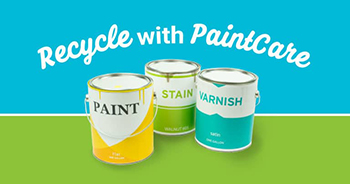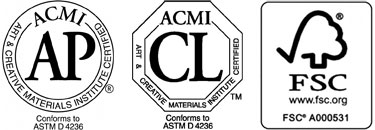Eco-Art Practices
EVERYDAY ECO PRACTICES – REUSE, RECYCLE, UPCYCLEWhether it’s Earth Day, or any day, practicing safe and ecologically sound practices in your daily life is so important when creating. Think of the environment as not only globally but in the sense of your personal workspace as it relates to your health and your surroundings. This basic information is focused on tools and methods you can use to lessen negative impacts on the earth, and yourself. We encourage you to ask questions and research related topics that you are concerned with. You can do that through manufacturer websites or by coming in and having a conversation with our staff. We encourage you to:
PAPER PRODUCTS Some journals and books use environmentally friendly soy inks for printing versus traditional petroleum-based inks. Typical printing inks emit toxic VOC’s, or volatile organic compounds which can be harmful to animals, humans and the environment. NON-TOXIC/LESS TOXIC SOLVENTS Currently there are safer and less toxic alternatives that are solvent-free and/or low-odor. COLOR a.k.a, Paint & Pigments This evolution has made oil painting one of the safest, least toxic and polluting and most natural of all paints. Hues have replaced, or are an alternative to the original pigment. Colors labeled as a hue are now very close to the original. They are also less expensive. Wipe off as much paint possible from palettes, brushes and other tools before rinsing them. And, use a tube wringer, or the like, to get the most paint out of your tubes. OTHER To find out which chemicals are in a given product, check its Materials Safety Data Sheet (MSDS), which lists ingredients and potential health hazards, and can be obtained from the manufacturer. By law, US schools cannot give art supplies without any hazard warning to K-6 school children. DISPOSAL/REPURPOSE/RECYCLE Save paint left on a palette by covering the palette to prohibit drying, scraping remaining printmaking ink off and put in an airtight jar that is suitable for storing solvents and paints. Use a tube wringer to squeeze out as much paint as possible from the tube when it’s near empty. There are also organizations such as RAFT (Resource Area for Teaching) that will take certain types of supplies (new or used) for reselling to educators at a low price. Do not put paints down the sink drain. When cleaning your palette, tubes, etc. wipe as much as you can off with a towel. Solvents should not be thrown into the trash or sink. You can take them to a disposal site, usually run by local governments. Here are some resources for waste disposal, recycling and reuse: 
This list is a good start for those in the Denver/Boulder/Colorado Springs area. OTHER PREVENTATIVE MEASURES:
ECO-MATERIALS AT MEININGER ART SUPPLY:PAPER PENCILS EASELS SOLVENTS STATIONERY OTHER ITEMS |
Questions?
DENVER: 303-698-3838 | 1-800-950-ARTS [2787]
COLORADO SPRINGS: 719-578-8070


 Look for:
Look for: